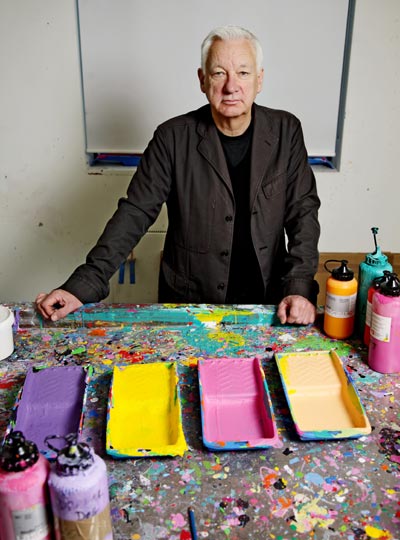 |
|
British conceptual artist Michael Craig-Martin, acclaimed as Godfather of Brit Art, will stage his solo show in Shanghai in January, following his current show in Hong Kong. Chris McAndrew / China Daily
|
London newspaper The Telegraph declared him "the high priest of ordinary things", but the task facing world-renowned conceptual artist Michael Craig-Martin at the Himalayas Art Museum in Shanghai is anything but ordinary.
Craig-Martin has taken up the challenge of mounting a solo exhibition filling six halls of the 28,000-square-meter museum-by January.
"The place is very big," he says. "It's a kind of exhibition space that one might think of for a retrospective. I've been given six large rooms, and you could put a lifetime of work there."
The exhibition will feature more than 80 paintings which he has been working on for more than two years.
He began in the 1970s, drawing ordinary objects, wheelbarrows, wooden gates, garden forks, paint rollers and other objects which became transformed into drawings, paintings and steel sculpture rendered as concisely as possible.
"It would have been inconceivable to me that they would remain at the center of my work to this day. I intended them to be 'styleless', but over the years the way they look has come to be recognizable as my style," the artist says.
Craig-Martin's Himalayas premiere will follow his current exhibition at the Gagosian Gallery in the Pedder Building, Central, Hong Kong, which continues until Aug 16.
The exhibition of more than a dozen paintings continues a departure from his early works as a sculptor.
A standout digital portrait of the Duchess of Devonshire, Lady Laura Burlington, near the gallery's door employs constantly shifting hues so that the image's mood is never the same twice. The highly colored depictions of modern, mass produced items that normally go unnoticed-the simple and clean lines of a violin, the threads in a winged corkscrew, the molded plastic of binoculars and the subtly undulating seams of a tennis ball.
The colors are meant to convey the non-visual sensations-the smell, taste, feel and sound-of the objects, he says. The meticulously painted pieces produce machine-perfect lines and shades, but done by hand.
The Gagosian show is his first since he came to Hong Kong in 1976 to visit one of his former pupils from Goldsmiths University of London, where he served as a tutor in the 1980s.
"(Hong Kong) was quite different then. The Pedder Building was here but nothing else around it was," Craig-Martin says. He was visiting Hong Kong sculptor Antonio Mak and was introduced to Johnson Chang, who is now curator and guest professor of the China Academy of Art in Hangzhou.
